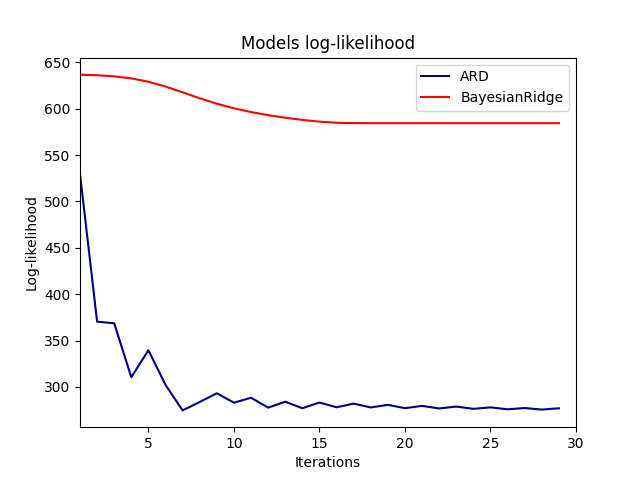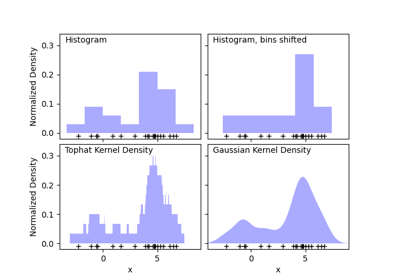Note
Go to the end to download the full example code. or to run this example in your browser via Binder
比较线性贝叶斯回归器#
本示例比较了两种不同的贝叶斯回归器:
自动相关性确定
贝叶斯岭回归
在第一部分中,我们使用 普通最小二乘法 (OLS) 模型作为基准,比较模型系数与真实系数。随后,我们展示了通过迭代最大化观测值的边际对数似然来估计这些模型。
在最后一部分中,我们使用多项式特征扩展来拟合 X 和 y 之间的非线性关系,并绘制了 ARD 和贝叶斯岭回归的预测和不确定性。
# Author: Arturo Amor <david-arturo.amor-quiroz@inria.fr>
模型的鲁棒性以恢复真实权重#
生成合成数据集#
我们生成了一个数据集,其中 X 和 y 具有线性关系: X 的 10 个特征将用于生成 y 。其他特征对预测 y 没有用。此外,我们生成了一个 n_samples == n_features 的数据集。对于普通最小二乘法(OLS)模型来说,这样的设置是具有挑战性的,并且可能导致权重任意增大。对权重施加先验和惩罚可以缓解这个问题。最后,添加了高斯噪声。
from sklearn.datasets import make_regression
X, y, true_weights = make_regression(
n_samples=100,
n_features=100,
n_informative=10,
noise=8,
coef=True,
random_state=42,
)
拟合回归模型#
我们现在拟合贝叶斯模型和普通最小二乘法(OLS),以便稍后比较模型的系数。
import pandas as pd
from sklearn.linear_model import ARDRegression, BayesianRidge, LinearRegression
olr = LinearRegression().fit(X, y)
brr = BayesianRidge(compute_score=True, max_iter=30).fit(X, y)
ard = ARDRegression(compute_score=True, max_iter=30).fit(X, y)
df = pd.DataFrame(
{
"Weights of true generative process": true_weights,
"ARDRegression": ard.coef_,
"BayesianRidge": brr.coef_,
"LinearRegression": olr.coef_,
}
)
绘制真实和估计的系数#
现在我们将每个模型的系数与真实生成模型的权重进行比较。
import matplotlib.pyplot as plt
import seaborn as sns
from matplotlib.colors import SymLogNorm
plt.figure(figsize=(10, 6))
ax = sns.heatmap(
df.T,
norm=SymLogNorm(linthresh=10e-4, vmin=-80, vmax=80),
cbar_kws={"label": "coefficients' values"},
cmap="seismic_r",
)
plt.ylabel("linear model")
plt.xlabel("coefficients")
plt.tight_layout(rect=(0, 0, 1, 0.95))
_ = plt.title("Models' coefficients")

由于添加了噪声,所有模型都无法恢复真实权重。实际上,所有模型总是有超过10个非零系数。与OLS估计相比,使用贝叶斯岭回归的系数略微向零偏移,这使它们更加稳定。ARD回归提供了一个更稀疏的解决方案:一些无信息系数被精确地设为零,而其他系数则更接近于零。一些无信息系数仍然存在并保持较大的值。
绘制边际对数似然函数#
import numpy as np
ard_scores = -np.array(ard.scores_)
brr_scores = -np.array(brr.scores_)
plt.plot(ard_scores, color="navy", label="ARD")
plt.plot(brr_scores, color="red", label="BayesianRidge")
plt.ylabel("Log-likelihood")
plt.xlabel("Iterations")
plt.xlim(1, 30)
plt.legend()
_ = plt.title("Models log-likelihood")

确实,这两种模型都将对数似然函数最小化到由 max_iter 参数定义的任意截止点。
Bayesian regressions with polynomial feature expansion#
生成合成数据集#
We create a target that is a non-linear function of the input feature. Noise following a standard uniform distribution is added.
from sklearn.pipeline import make_pipeline
from sklearn.preprocessing import PolynomialFeatures, StandardScaler
rng = np.random.RandomState(0)
n_samples = 110
# 对数据进行排序,以便后续绘图更容易进行
X = np.sort(-10 * rng.rand(n_samples) + 10)
noise = rng.normal(0, 1, n_samples) * 1.35
y = np.sqrt(X) * np.sin(X) + noise
full_data = pd.DataFrame({"input_feature": X, "target": y})
X = X.reshape((-1, 1))
# 外推
#
#
X_plot = np.linspace(10, 10.4, 10)
y_plot = np.sqrt(X_plot) * np.sin(X_plot)
X_plot = np.concatenate((X, X_plot.reshape((-1, 1))))
y_plot = np.concatenate((y - noise, y_plot))
拟合回归模型#
在这里,我们尝试使用10次多项式来潜在地过拟合,尽管贝叶斯线性模型会对多项式系数的大小进行正则化。由于对于:class:~sklearn.linear_model.ARDRegression 和:class:~sklearn.linear_model.BayesianRidge , fit_intercept=True 是默认设置,因此:class:~sklearn.preprocessing.PolynomialFeatures 不应引入额外的偏差特征。通过设置 return_std=True ,贝叶斯回归器会返回模型参数后验分布的标准差。
ard_poly = make_pipeline(
PolynomialFeatures(degree=10, include_bias=False),
StandardScaler(),
ARDRegression(),
).fit(X, y)
brr_poly = make_pipeline(
PolynomialFeatures(degree=10, include_bias=False),
StandardScaler(),
BayesianRidge(),
).fit(X, y)
y_ard, y_ard_std = ard_poly.predict(X_plot, return_std=True)
y_brr, y_brr_std = brr_poly.predict(X_plot, return_std=True)
绘制带有分数标准误差的多项式回归图#
ax = sns.scatterplot(
data=full_data, x="input_feature", y="target", color="black", alpha=0.75
)
ax.plot(X_plot, y_plot, color="black", label="Ground Truth")
ax.plot(X_plot, y_brr, color="red", label="BayesianRidge with polynomial features")
ax.plot(X_plot, y_ard, color="navy", label="ARD with polynomial features")
ax.fill_between(
X_plot.ravel(),
y_ard - y_ard_std,
y_ard + y_ard_std,
color="navy",
alpha=0.3,
)
ax.fill_between(
X_plot.ravel(),
y_brr - y_brr_std,
y_brr + y_brr_std,
color="red",
alpha=0.3,
)
ax.legend()
_ = ax.set_title("Polynomial fit of a non-linear feature")

误差条表示查询点的预测高斯分布的一个标准差。请注意,当在两个模型中使用默认参数时,ARD回归最好地捕捉到了真实情况,但进一步减少贝叶斯岭回归的 lambda_init 超参数可以减少其偏差(参见示例
使用贝叶斯岭回归进行曲线拟合 )。
最后,由于多项式回归的内在局限性,两个模型在外推时都失败了。
Total running time of the script: (0 minutes 1.747 seconds)
Related examples





